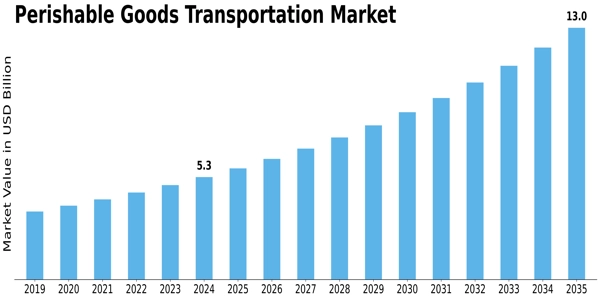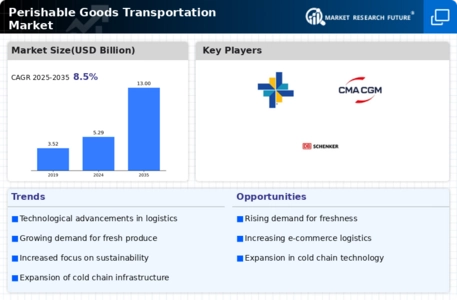-
EXECUTIVE SUMMARY
-
MARKET INTRODUCTION
-
Definition
-
Scope of the Study
- Research Objective
- Limitations
-
Assumptions
-
RESEARCH METHODOLOGY
-
Overview
-
Data Mining
-
Secondary Research
- Primary Interviews and Information Gathering Process
-
Primary Research
-
Breakdown of Primary Respondents
-
Forecasting Model
- Bottom-Up Approach
- Top-Down
-
Market Size Estimation
-
Approach
-
Data Triangulation
-
Validation
-
MARKET DYNAMICS
-
Overview
-
Drivers
-
Restraints
-
Opportunities
-
MARKET FACTOR ANALYSIS
-
Value Chain Analysis
- Bargaining Power of Suppliers
- Threat of New Entrants
- Intensity of Rivalry
-
Porter’s Five Forces Analysis
-
Bargaining Power of Buyers
-
Threat of Substitutes
-
COVID-19
- Market Impact Analysis
- Regional
- Opportunity and Threat Analysis
-
Impact Analysis
-
Impact
-
GLOBAL PERISHABLE
-
GOODS TRANSPORTATION MARKET, BY TYPE
-
Overview
-
MPS
-
Dairy and Frozen Desserts
-
Vegetables & Fruits
-
Bakery & Confectionery
-
GLOBAL PERISHABLE GOODS TRANSPORTATION MARKET,
-
BY MODE OF TRANSPORTATION
-
Overview
-
Rail Transportation
-
Air Transportation
-
Marine Transportation
-
Road Transportation
-
GLOBAL PERISHABLE GOODS TRANSPORTATION MARKET, BY REGION
-
Overview
- US
- Canada
-
North America
-
Europe
- France
- UK
- Italy
- Rest of Europe
-
Germany
-
Spain
-
Asia-Pacific
- India
- Japan
- South Korea
- Rest of Asia-Pacific
-
China
-
Australia
-
Rest of the World
- Africa
- Latin America
-
Middle East
-
COMPETITIVE LANDSCAPE
-
Overview
-
Competitive Analysis
-
Market Share Analysis
-
Major Growth Strategy in the Global Perishable
-
Goods Transportation Market,
-
Competitive Benchmarking
-
Leading Players in Terms of Number of Developments in the Global Perishable Goods
-
Transportation Market,
-
Key developments and Growth Strategies
- Merger & Acquisitions
-
New Product Launch/Service Deployment
-
Joint Ventures
-
Major Players Financial Matrix
- Sales
- Major Players R&D Expenditure.
-
& Operating Income, 2022
-
COMPANY PROFILES
-
Africa Express Line Limited
- Financial Overview
- Products
- Key Developments
- SWOT Analysis
-
Company Overview
-
Offered
-
Key Strategies
-
Bay & Bay Transportation
- Company
- Financial Overview
- Products Offered
- SWOT Analysis
- Key Strategies
- Company Overview
- Products Offered
- Key Developments
- Key Strategies
-
Overview
-
Key Developments
-
C.H. ROBINSON WORLDWIDE INC
-
Financial Overview
-
SWOT Analysis
-
CMA CGM Group (MERIT
- Company Overview
- Financial Overview
- Key Developments
- SWOT Analysis
-
France SAS)
-
Products Offered
-
Key Strategies
-
DB Schenker
- Company Overview
- Products Offered
- Key Developments
- Key Strategies
-
Financial Overview
-
SWOT Analysis
-
Deutsche Post AG
- Financial Overview
- Products
- Key Developments
- SWOT Analysis
-
Company Overview
-
Offered
-
Key Strategies
-
FST Logistics Inc
- Company Overview
- Products Offered
- Key Developments
- Key Strategies
-
Financial Overview
-
SWOT Analysis
-
Hapag-Lloyd AG
- Financial Overview
- Products
- Key Developments
- SWOT Analysis
-
Company Overview
-
Offered
-
Key Strategies
-
Hellmann Worldwide Logistics SE
- Financial Overview
- Products
- Key Developments
- SWOT Analysis
-
Company Overview
-
Offered
-
Key Strategies
-
K Line Logistics Ltd (Kawasaki Kisen Kaisha Ltd)
- Financial Overview
- Products
- Key Developments
- SWOT Analysis
-
Company Overview
-
Offered
-
Key Strategies
-
APPENDIX
-
References
-
Related Reports
-
LIST OF TABLES
-
GLOBAL PERISHABLE GOODS
-
TRANSPORTATION MARKET, SYNOPSIS, 2018-2032
-
GLOBAL PERISHABLE GOODS
-
TRANSPORTATION MARKET, ESTIMATES & FORECAST, 2018-2032 (USD BILLION)
-
TABLE
-
GLOBAL PERISHABLE GOODS TRANSPORTATION MARKET, BY TYPE, 2018-2032 (USD BILLION)
-
TABLE
-
GLOBAL PERISHABLE GOODS TRANSPORTATION MARKET, BY MODE OF TRANSPORTATION, 2018-2032
-
(USD BILLION)
-
NORTH AMERICA: PERISHABLE GOODS TRANSPORTATION MARKET,
-
BY TYPE, 2018-2032 (USD BILLION)
-
NORTH AMERICA: PERISHABLE GOODS
-
TRANSPORTATION MARKET, BY MODE OF TRANSPORTATION, 2018-2032 (USD BILLION)
-
TABLE
-
US: PERISHABLE GOODS TRANSPORTATION MARKET, BY TYPE, 2018-2032 (USD BILLION)
-
TABLE
-
US: PERISHABLE GOODS TRANSPORTATION MARKET, BY MODE OF TRANSPORTATION, 2018-2032
-
(USD BILLION)
-
CANADA: PERISHABLE GOODS TRANSPORTATION MARKET,
-
BY TYPE, 2018-2032 (USD BILLION)
-
CANADA: PERISHABLE GOODS TRANSPORTATION
-
MARKET, BY MODE OF TRANSPORTATION, 2018-2032 (USD BILLION)
-
EUROPE:
-
PERISHABLE GOODS TRANSPORTATION MARKET, BY TYPE, 2018-2032 (USD BILLION)
-
TABLE
-
EUROPE: PERISHABLE GOODS TRANSPORTATION MARKET, BY MODE OF TRANSPORTATION, 2018-2032
-
(USD BILLION)
-
GERMANY: PERISHABLE GOODS TRANSPORTATION MARKET,
-
BY TYPE, 2018-2032 (USD BILLION)
-
GERMANY: PERISHABLE GOODS TRANSPORTATION
-
MARKET, BY MODE OF TRANSPORTATION, 2018-2032 (USD BILLION)
-
FRANCE:
-
PERISHABLE GOODS TRANSPORTATION MARKET, BY TYPE, 2018-2032 (USD BILLION)
-
TABLE
-
FRANCE: PERISHABLE GOODS TRANSPORTATION MARKET, BY MODE OF TRANSPORTATION, 2018-2032
-
(USD BILLION)
-
ITALY: PERISHABLE GOODS TRANSPORTATION MARKET, BY
-
TYPE, 2018-2032 (USD BILLION)
-
ITALY: PERISHABLE GOODS TRANSPORTATION
-
MARKET, BY MODE OF TRANSPORTATION, 2018-2032 (USD BILLION)
-
SPAIN:
-
PERISHABLE GOODS TRANSPORTATION MARKET, BY TYPE, 2018-2032 (USD BILLION)
-
TABLE
-
SPAIN: PERISHABLE GOODS TRANSPORTATION MARKET, BY MODE OF TRANSPORTATION, 2018-2032
-
(USD BILLION)
-
UK: PERISHABLE GOODS TRANSPORTATION MARKET, BY
-
TYPE, 2018-2032 (USD BILLION)
-
UK: PERISHABLE GOODS TRANSPORTATION
-
MARKET, BY MODE OF TRANSPORTATION, 2018-2032 (USD BILLION)
-
REST
-
OF EUROPE: PERISHABLE GOODS TRANSPORTATION MARKET, BY TYPE, 2018-2032 (USD BILLION)
-
TABLE
-
REST OF EUROPE: PERISHABLE GOODS TRANSPORTATION MARKET, BY MODE OF TRANSPORTATION,
-
ASIA-PACIFIC: PERISHABLE GOODS TRANSPORTATION
-
MARKET, BY TYPE, 2018-2032 (USD BILLION)
-
ASIA-PACIFIC: PERISHABLE
-
GOODS TRANSPORTATION MARKET, BY MODE OF TRANSPORTATION, 2018-2032 (USD BILLION)
-
TABLE
-
JAPAN: PERISHABLE GOODS TRANSPORTATION MARKET, BY TYPE, 2018-2032 (USD BILLION)
-
TABLE
-
JAPAN: PERISHABLE GOODS TRANSPORTATION MARKET, BY MODE OF TRANSPORTATION, 2018-2032
-
(USD BILLION)
-
CHINA: PERISHABLE GOODS TRANSPORTATION MARKET,
-
BY TYPE, 2018-2032 (USD BILLION)
-
CHINA: PERISHABLE GOODS TRANSPORTATION
-
MARKET, BY MODE OF TRANSPORTATION, 2018-2032 (USD BILLION)
-
INDIA:
-
PERISHABLE GOODS TRANSPORTATION MARKET, BY TYPE, 2018-2032 (USD BILLION)
-
TABLE
-
INDIA: PERISHABLE GOODS TRANSPORTATION MARKET, BY MODE OF TRANSPORTATION, 2018-2032
-
(USD BILLION)
-
AUSTRALIA: PERISHABLE GOODS TRANSPORTATION MARKET,
-
BY TYPE, 2018-2032 (USD BILLION)
-
AUSTRALIA: PERISHABLE GOODS
-
TRANSPORTATION MARKET, BY MODE OF TRANSPORTATION, 2018-2032 (USD BILLION)
-
TABLE
-
SOUTH KOREA: PERISHABLE GOODS TRANSPORTATION MARKET, BY TYPE, 2018-2032 (USD
-
BILLION)
-
SOUTH KOREA: PERISHABLE GOODS TRANSPORTATION MARKET,
-
BY MODE OF TRANSPORTATION, 2018-2032 (USD BILLION)
-
REST OF ASIA-PACIFIC:
-
PERISHABLE GOODS TRANSPORTATION MARKET, BY TYPE, 2018-2032 (USD BILLION)
-
TABLE
-
REST OF ASIA-PACIFIC: PERISHABLE GOODS TRANSPORTATION MARKET, BY MODE OF TRANSPORTATION,
-
REST OF THE WORLD: PERISHABLE GOODS TRANSPORTATION
-
MARKET, BY TYPE, 2018-2032 (USD BILLION)
-
REST OF THE WORLD: PERISHABLE
-
GOODS TRANSPORTATION MARKET, BY MODE OF TRANSPORTATION, 2018-2032 (USD BILLION)
-
TABLE
-
MIDDLE EAST: PERISHABLE GOODS TRANSPORTATION MARKET, BY TYPE, 2018-2032 (USD
-
BILLION)
-
MIDDLE EAST: PERISHABLE GOODS TRANSPORTATION MARKET,
-
BY MODE OF TRANSPORTATION, 2018-2032 (USD BILLION)
-
AFRICA: PERISHABLE
-
GOODS TRANSPORTATION MARKET, BY TYPE, 2018-2032 (USD BILLION)
-
TABLE 34
-
AFRICA: PERISHABLE GOODS TRANSPORTATION MARKET, BY MODE OF TRANSPORTATION, 2018-2032
-
(USD BILLION)
-
LATIN AMERICA: PERISHABLE GOODS TRANSPORTATION
-
MARKET, BY TYPE, 2018-2032 (USD BILLION)
-
LATIN AMERICA: PERISHABLE
-
GOODS TRANSPORTATION MARKET, BY MODE OF TRANSPORTATION, 2018-2032 (USD BILLION)
-
LIST
-
OF FIGURES
-
RESEARCH PROCESS
-
MARKET STRUCTURE
-
FOR THE GLOBAL PERISHABLE GOODS TRANSPORTATION MARKET
-
MARKET
-
DYNAMICS FOR THE GLOBAL PERISHABLE GOODS TRANSPORTATION MARKET
-
FIGURE
-
GLOBAL PERISHABLE GOODS TRANSPORTATION MARKET, SHARE (%), BY TYPE, 2022
-
FIGURE
-
GLOBAL PERISHABLE GOODS TRANSPORTATION MARKET, SHARE (%), BY MODE OF TRANSPORTATION,
-
GLOBAL PERISHABLE GOODS TRANSPORTATION MARKET, SHARE (%),
-
BY REGION, 2022
-
NORTH AMERICA: PERISHABLE GOODS TRANSPORTATION
-
MARKET, SHARE (%), BY REGION, 2022
-
EUROPE: PERISHABLE GOODS TRANSPORTATION
-
MARKET, SHARE (%), BY REGION, 2022
-
ASIA-PACIFIC: PERISHABLE GOODS
-
TRANSPORTATION MARKET, SHARE (%), BY REGION, 2022
-
REST OF THE
-
WORLD: PERISHABLE GOODS TRANSPORTATION MARKET, SHARE (%), BY REGION, 2022
-
FIGURE
-
GLOBAL PERISHABLE GOODS TRANSPORTATION MARKET: COMPANY SHARE ANALYSIS, 2022 (%)
-
FIGURE
-
AFRICA EXPRESS LINE LIMITED: FINANCIAL OVERVIEW SNAPSHOT
-
FIGURE 13
-
AFRICA EXPRESS LINE LIMITED: SWOT ANALYSIS
-
BAY & BAY TRANSPORTATION:
-
FINANCIAL OVERVIEW SNAPSHOT
-
BAY & BAY TRANSPORTATION: SWOT
-
ANALYSIS
-
C.H. ROBINSON WORLDWIDE INC: FINANCIAL OVERVIEW SNAPSHOT
-
FIGURE
-
C.H. ROBINSON WORLDWIDE INC: SWOT ANALYSIS
-
CMA CGM GROUP
-
(MERIT FRANCE SAS): FINANCIAL OVERVIEW SNAPSHOT
-
CMA CGM GROUP
-
(MERIT FRANCE SAS): SWOT ANALYSIS
-
DB SCHENKER: FINANCIAL OVERVIEW
-
SNAPSHOT
-
DB SCHENKER: SWOT ANALYSIS
-
DEUTSCHE
-
POST AG: FINANCIAL OVERVIEW SNAPSHOT
-
DEUTSCHE POST AG: SWOT
-
ANALYSIS
-
FST LOGISTICS INC: FINANCIAL OVERVIEW SNAPSHOT
-
FIGURE
-
FST LOGISTICS INC: SWOT ANALYSIS
-
HAPAG-LLOYD AG: FINANCIAL
-
OVERVIEW SNAPSHOT
-
HAPAG-LLOYD AG: SWOT ANALYSIS
-
FIGURE
-
HELLMANN WORLDWIDE LOGISTICS SE: FINANCIAL OVERVIEW SNAPSHOT
-
FIGURE
-
HELLMANN WORLDWIDE LOGISTICS SE: SWOT ANALYSIS
-
K LINE LOGISTICS
-
LTD (KAWASAKI KISEN KAISHA LTD): FINANCIAL OVERVIEW SNAPSHOT
-
FIGURE 31
-
K LINE LOGISTICS LTD (KAWASAKI KISEN KAISHA LTD): SWOT ANALYSIS















Leave a Comment